Abstract
The percentage of human granulocytes expressing the integrins CD11b and CD11c as well as complement receptor 1 (CD35) was increased by short-term incubation of whole blood with interleukin-2 (IL-2), interleukin-4 (IL-4) and tumour necrosis factors alpha and beta (TNF-alpha and TNF-beta). The mean fluorescence intensity of granulocyte CD18 was also increased by the above cytokines, whilst that of CD11b was only increased by TNF-alpha. Up-regulation of granulocyte CD18 expression was seen with 1 U/ml of IL-2, TNF-alpha or TNF-beta, in contrast to the effect of IL-4 which was only observed with 100 U/ml. Similarly, enhanced expression of CD35 was induced by 1 U/ml of IL-2 or TNF-alpha but not by concentrations of IL-4 or TNF-beta lower than 100 U/ml. Cytokine effects on the CD11/CD18 complex and CD35 molecules were not modified by cycloheximide, suggesting that their increased expression was not due simply to synthesis de novo. None of the granulocyte surface determinants investigated was altered upon short-term incubation of blood with either IL-1, IL-6 or interferon-gamma (IFN-gamma). The demonstration in vitro that cytokines selectively up-regulate granulocyte integrins and complement receptor 1, suggests that similar mechanisms may be operating during the control of granulocyte-mediated inflammatory processes.
Full text
PDF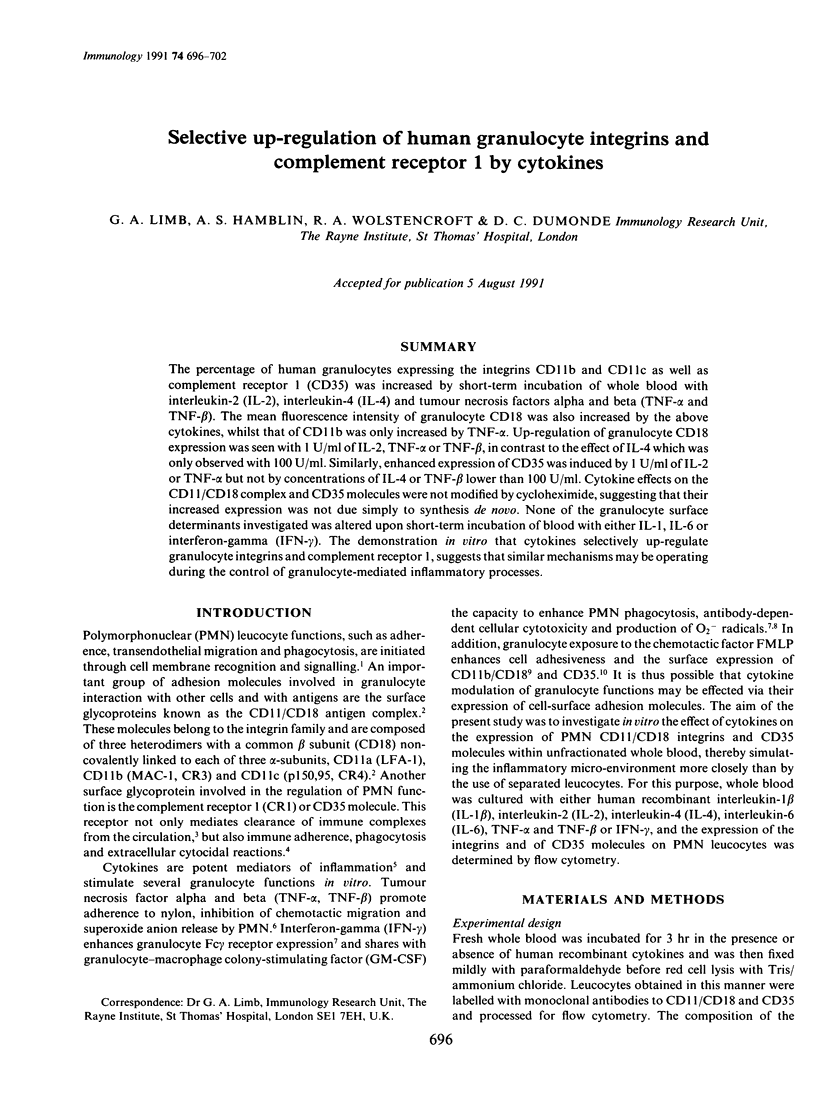

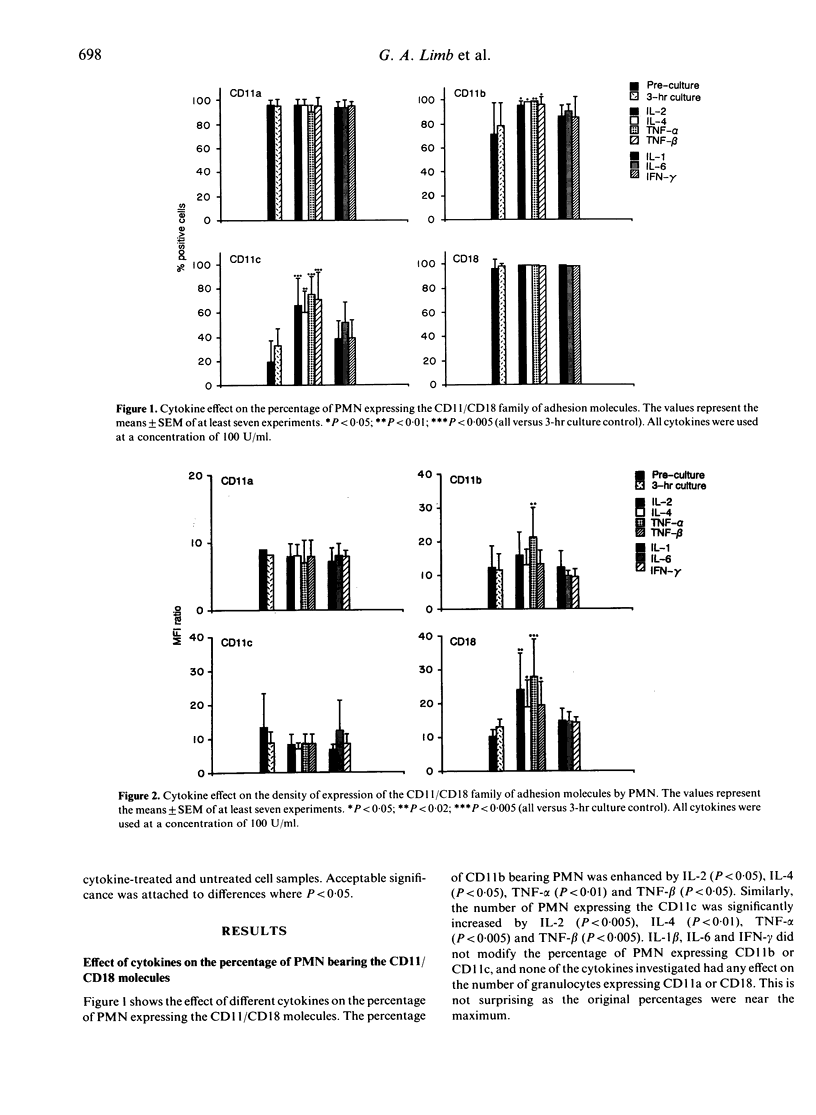
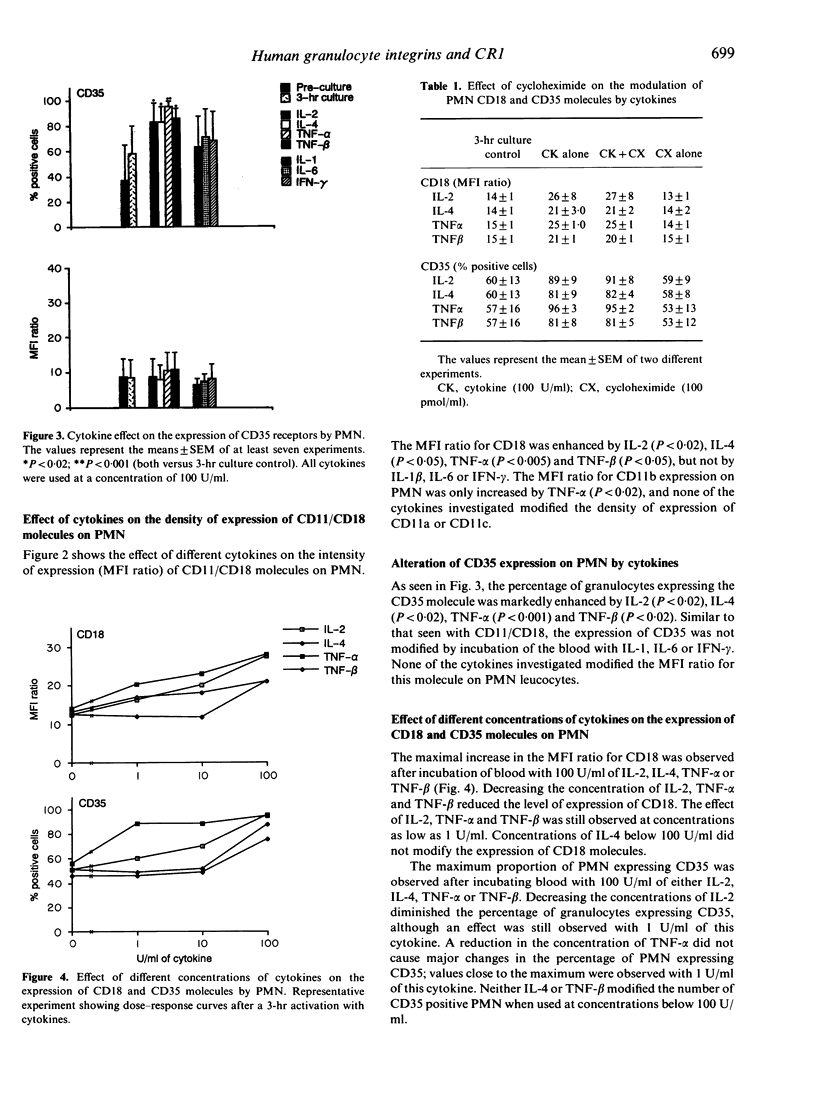
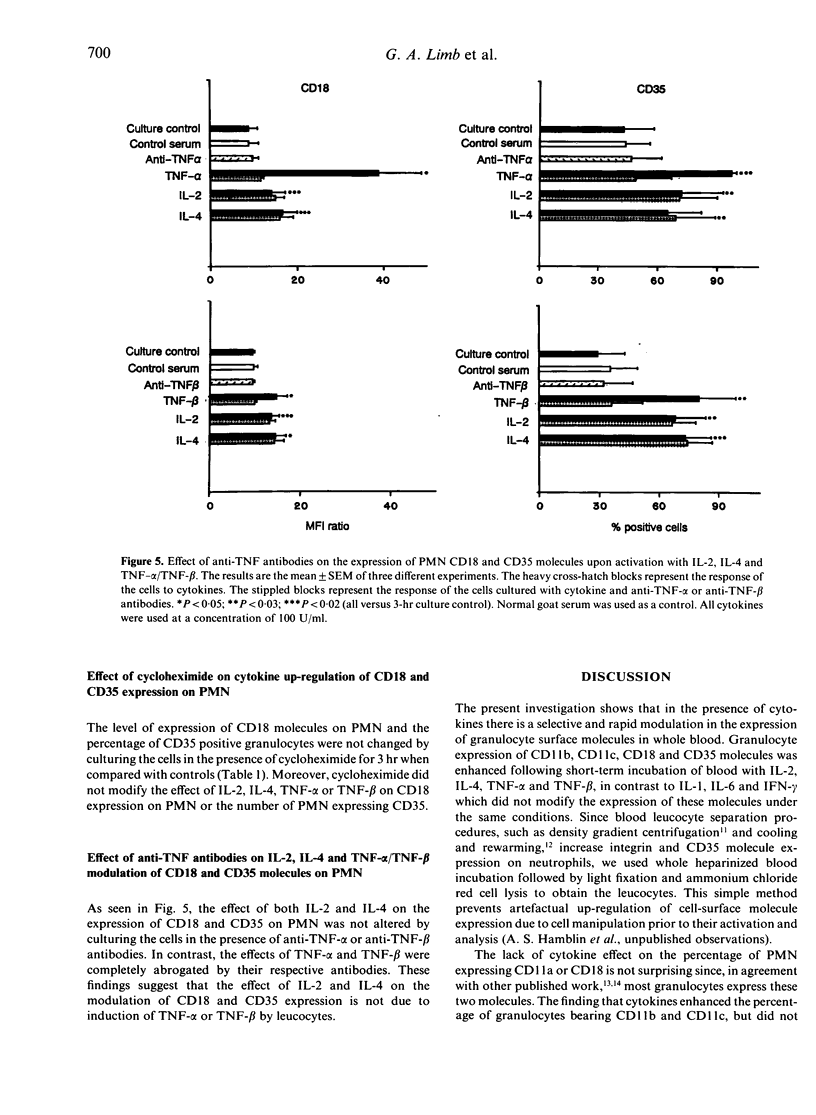
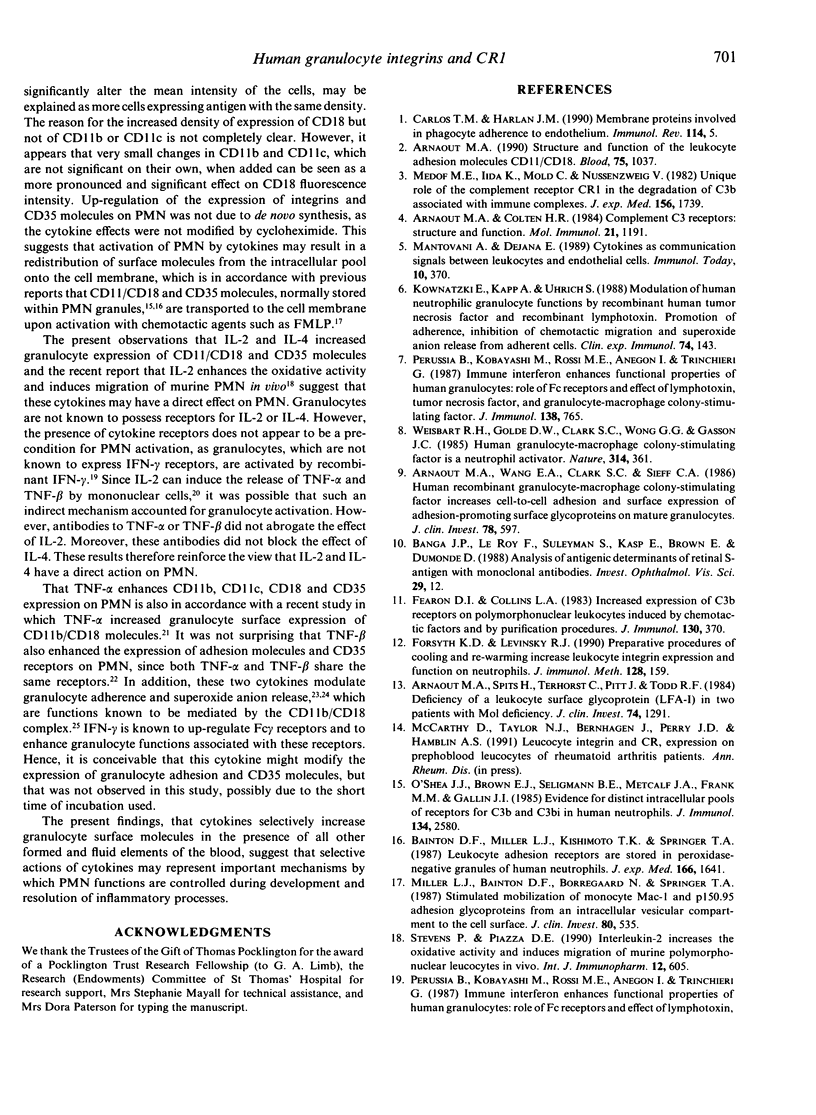
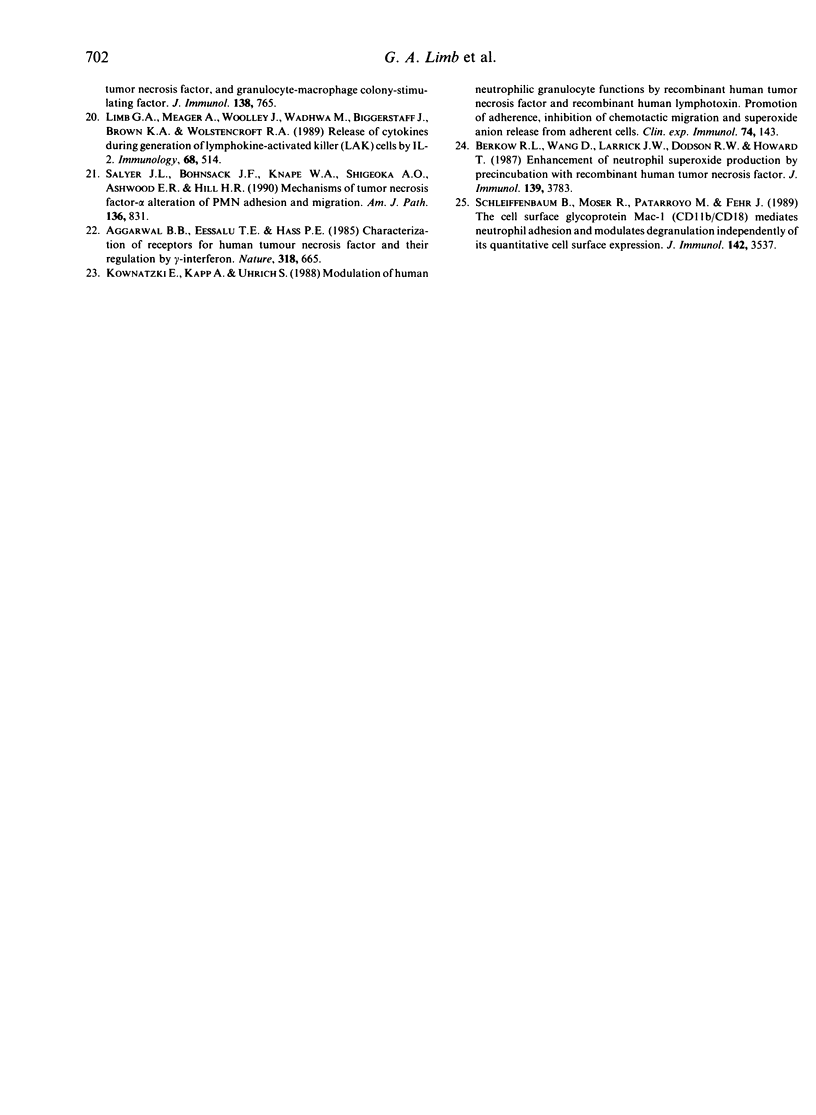
Selected References
These references are in PubMed. This may not be the complete list of references from this article.
- Aggarwal B. B., Eessalu T. E., Hass P. E. Characterization of receptors for human tumour necrosis factor and their regulation by gamma-interferon. Nature. 1985 Dec 19;318(6047):665–667. doi: 10.1038/318665a0. [DOI] [PubMed] [Google Scholar]
- Arnaout M. A., Colten H. R. Complement C3 receptors: structure and function. Mol Immunol. 1984 Dec;21(12):1191–1199. doi: 10.1016/0161-5890(84)90009-9. [DOI] [PubMed] [Google Scholar]
- Arnaout M. A., Spits H., Terhorst C., Pitt J., Todd R. F., 3rd Deficiency of a leukocyte surface glycoprotein (LFA-1) in two patients with Mo1 deficiency. Effects of cell activation on Mo1/LFA-1 surface expression in normal and deficient leukocytes. J Clin Invest. 1984 Oct;74(4):1291–1300. doi: 10.1172/JCI111539. [DOI] [PMC free article] [PubMed] [Google Scholar]
- Arnaout M. A. Structure and function of the leukocyte adhesion molecules CD11/CD18. Blood. 1990 Mar 1;75(5):1037–1050. [PubMed] [Google Scholar]
- Arnaout M. A., Wang E. A., Clark S. C., Sieff C. A. Human recombinant granulocyte-macrophage colony-stimulating factor increases cell-to-cell adhesion and surface expression of adhesion-promoting surface glycoproteins on mature granulocytes. J Clin Invest. 1986 Aug;78(2):597–601. doi: 10.1172/JCI112615. [DOI] [PMC free article] [PubMed] [Google Scholar]
- Bainton D. F., Miller L. J., Kishimoto T. K., Springer T. A. Leukocyte adhesion receptors are stored in peroxidase-negative granules of human neutrophils. J Exp Med. 1987 Dec 1;166(6):1641–1653. doi: 10.1084/jem.166.6.1641. [DOI] [PMC free article] [PubMed] [Google Scholar]
- Berkow R. L., Wang D., Larrick J. W., Dodson R. W., Howard T. H. Enhancement of neutrophil superoxide production by preincubation with recombinant human tumor necrosis factor. J Immunol. 1987 Dec 1;139(11):3783–3791. [PubMed] [Google Scholar]
- Carlos T. M., Harlan J. M. Membrane proteins involved in phagocyte adherence to endothelium. Immunol Rev. 1990 Apr;114:5–28. doi: 10.1111/j.1600-065x.1990.tb00559.x. [DOI] [PubMed] [Google Scholar]
- Fearon D. T., Collins L. A. Increased expression of C3b receptors on polymorphonuclear leukocytes induced by chemotactic factors and by purification procedures. J Immunol. 1983 Jan;130(1):370–375. [PubMed] [Google Scholar]
- Forsyth K. D., Levinsky R. J. Preparative procedures of cooling and re-warming increase leukocyte integrin expression and function on neutrophils. J Immunol Methods. 1990 Apr 17;128(2):159–163. doi: 10.1016/0022-1759(90)90206-b. [DOI] [PubMed] [Google Scholar]
- Kownatzki E., Kapp A., Uhrich S. Modulation of human neutrophilic granulocyte functions by recombinant human tumor necrosis factor and recombinant human lymphotoxin. Promotion of adherence, inhibition of chemotactic migration and superoxide anion release from adherent cells. Clin Exp Immunol. 1988 Oct;74(1):143–148. [PMC free article] [PubMed] [Google Scholar]
- Kownatzki E., Kapp A., Uhrich S. Modulation of human neutrophilic granulocyte functions by recombinant human tumor necrosis factor and recombinant human lymphotoxin. Promotion of adherence, inhibition of chemotactic migration and superoxide anion release from adherent cells. Clin Exp Immunol. 1988 Oct;74(1):143–148. [PMC free article] [PubMed] [Google Scholar]
- Limb G. A., Meager A., Woolley J., Wadhwa M., Biggerstaff J., Brown K. A., Wolstencroft R. A. Release of cytokines during generation of lymphokine-activated killer (LAK) cells by IL-2. Immunology. 1989 Dec;68(4):514–519. [PMC free article] [PubMed] [Google Scholar]
- Mantovani A., Dejana E. Cytokines as communication signals between leukocytes and endothelial cells. Immunol Today. 1989 Nov;10(11):370–375. doi: 10.1016/0167-5699(89)90270-3. [DOI] [PubMed] [Google Scholar]
- Medof M. E., Iida K., Mold C., Nussenzweig V. Unique role of the complement receptor CR1 in the degradation of C3b associated with immune complexes. J Exp Med. 1982 Dec 1;156(6):1739–1754. doi: 10.1084/jem.156.6.1739. [DOI] [PMC free article] [PubMed] [Google Scholar]
- Miller L. J., Bainton D. F., Borregaard N., Springer T. A. Stimulated mobilization of monocyte Mac-1 and p150,95 adhesion proteins from an intracellular vesicular compartment to the cell surface. J Clin Invest. 1987 Aug;80(2):535–544. doi: 10.1172/JCI113102. [DOI] [PMC free article] [PubMed] [Google Scholar]
- O'Shea J. J., Brown E. J., Seligmann B. E., Metcalf J. A., Frank M. M., Gallin J. I. Evidence for distinct intracellular pools of receptors for C3b and C3bi in human neutrophils. J Immunol. 1985 Apr;134(4):2580–2587. [PubMed] [Google Scholar]
- Perussia B., Kobayashi M., Rossi M. E., Anegon I., Trinchieri G. Immune interferon enhances functional properties of human granulocytes: role of Fc receptors and effect of lymphotoxin, tumor necrosis factor, and granulocyte-macrophage colony-stimulating factor. J Immunol. 1987 Feb 1;138(3):765–774. [PubMed] [Google Scholar]
- Salyer J. L., Bohnsack J. F., Knape W. A., Shigeoka A. O., Ashwood E. R., Hill H. R. Mechanisms of tumor necrosis factor-alpha alteration of PMN adhesion and migration. Am J Pathol. 1990 Apr;136(4):831–841. [PMC free article] [PubMed] [Google Scholar]
- Schleiffenbaum B., Moser R., Patarroyo M., Fehr J. The cell surface glycoprotein Mac-1 (CD11b/CD18) mediates neutrophil adhesion and modulates degranulation independently of its quantitative cell surface expression. J Immunol. 1989 May 15;142(10):3537–3545. [PubMed] [Google Scholar]
- Stevens P., Piazza D. E. Interleukin-2 increases the oxidative activity and induces migration of murine polymorphonuclear leukocytes in vivo. Int J Immunopharmacol. 1990;12(6):605–611. doi: 10.1016/0192-0561(90)90097-7. [DOI] [PubMed] [Google Scholar]
- Weisbart R. H., Golde D. W., Clark S. C., Wong G. G., Gasson J. C. Human granulocyte-macrophage colony-stimulating factor is a neutrophil activator. 1985 Mar 28-Apr 3Nature. 314(6009):361–363. doi: 10.1038/314361a0. [DOI] [PubMed] [Google Scholar]


